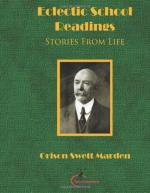Her literary talent was developed at a very early age. One of her friends has humorously said that “Mrs. Howe wrote leading articles from her cradle.” However this may be, it is undoubtedly true that at seventeen she contributed valuable articles to a leading New York magazine. In 1854 she published her first volume of poems, “Passion Flowers.” Other volumes, including collections of her later poems, books of travel, and a biography of Margaret Fuller, were afterward published. For more than half a century she has been a constant contributor to the leading magazines of the country.
Since 1869 Mrs. Howe has been a leader in the movement for woman’s suffrage, and both by lecturing and writing has supported every effort put forth for the educational and general advancement of her sex.
Although in her eightieth year when the writer conversed with her a few years ago, Mrs. Howe was then full of youthful enthusiasm, and her interest in the great movements of the world was as keen as ever. Age had in no way lessened her intellectual vigor. Surrounded by her children and grandchildren, and one great-grandchild, she recently celebrated her eighty-fourth birthday.
The story of “The Battle Hymn of the Republic” has been left to the last, not because it is the least important, but, on the contrary, because it is one of the most important works of her life. Certain it is that the “Battle Hymn” will live and thrill the hearts of Americans centuries after its author has passed on to the other life.
The hymn was written in Washington, in November, 1861, the first year of our Civil War. Dr. and Mrs. Howe were visiting friends in that city. During their stay, they went one day with a party to see a review of Union troops. The review, however, was interrupted by a movement of the Confederate forces which were besieging the city. On their return, the carriage in which Mrs. Howe and her friends were seated was surrounded by soldiers. Stirred by the scene and the occasion, she began to sing “John Brown,” to the delight of the soldiers, who heartily joined in the refrain.
At the close of the song Mrs. Howe expressed to her friends the strong desire she felt to write some words which might be sung to this stirring tune. But she added that she feared she would never be able to do so.
“That night,” says her daughter, Maude Howe Eliot, “she went to sleep full of thoughts of battle, and awoke before dawn the next morning to find the desired verses immediately present to her mind. She sprang from her bed, and in the dim gray light found a pen and paper, whereon she wrote, scarcely seeing them, the lines of the poem. Returning to her couch, she was soon asleep, but not until she had said to herself, ’I like this better than anything I have ever written before.’”
THE BATTLE HYMN OF THE REPUBLIC
Mine eyes have seen the glory of the coming of the
Lord: He is trampling out the vintage where the
grapes of wrath are stored; He hath loosed the fateful
lightning of His terrible swift sword:
His
truth is marching on.




